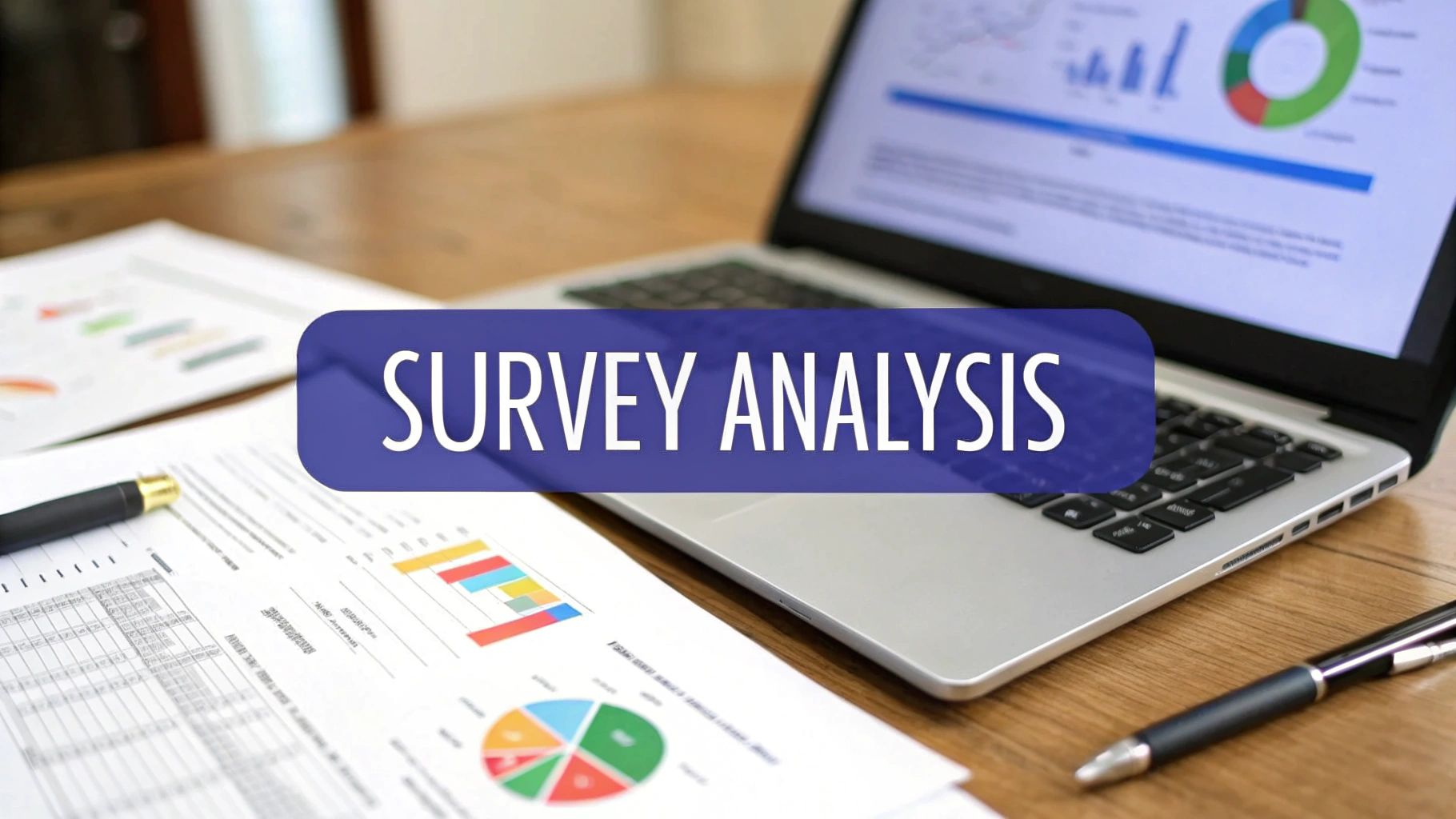A Guide to Surveys AI and Smarter Feedback
Discover how Surveys AI is changing data collection. This guide explains how AI-powered surveys work, their benefits, and how to get better insights.

AI is changing how surveys work, turning them from static, one-size-fits-all forms into dynamic, one-on-one conversations. Think of it less like a questionnaire and more like an intelligent interview.
This technology allows surveys to adapt on the fly, asking smart follow-up questions based on a user's answers, just like a skilled human interviewer would. The result is that you get more detailed, more authentic qualitative feedback, and you can get it at a scale that was never possible before.
What Are AI Surveys and Why Do They Matter?
Let's say you're trying to figure out why customers are leaving your SaaS product.
A traditional survey gives them a multiple-choice list: Price, Missing Features, or Poor Customer Service. This approach is neat and tidy, but it forces people into buckets. It often completely misses the genuine, nuanced reasons people make the decisions they do.
This is where AI surveys come in. Instead of sticking to a rigid script, an AI survey starts a conversation. If a customer mentions "price," the AI doesn't just check a box. It digs deeper.
It might ask, "Could you tell me a bit more about what felt overpriced?" or "What price point would have felt more reasonable for the value you were getting?"
This back-and-forth turns a simple form into an intelligent interview, uncovering the kind of insights that fixed-question surveys just can't touch. For businesses, this is a big advantage. It means moving beyond shallow data points to gather rich, actionable stories straight from your audience.
The Shift from Static Forms to Dynamic Conversations
The core difference here is adaptability. A standard online form is set in stone; every user gets the exact same questions in the same order. An AI survey, on the other hand, is alive and responsive, personalizing the experience for everyone.
This shift is a big deal for a few key reasons:
- Deeper Qualitative Insights: The AI can probe into open-ended answers, asking "why" and "how" to get to the bottom of user behavior.
- Better Engagement: A conversational format feels more natural and less robotic. This leads to higher completion rates and more thoughtful responses. People are far more willing to open up when they feel like they're actually being heard.
- Feedback at Scale: Getting this level of detail used to mean hours of one-on-one interviews. With AI, you can have thousands of these in-depth conversations happening all at once.
An AI survey is a way to automate empathy at scale. It listens, adapts, and learns from each user, giving you a direct line to the true voice of your customer.
For SaaS companies, this is especially important. Product, marketing, and customer success teams all rely on a crystal-clear picture of the user experience. Superficial data leads to flawed assumptions, but detailed, honest feedback fuels real innovation and growth.
When you know the why behind what your users are doing, you can build better products, craft messaging that connects, and dramatically improve the entire customer journey. You can learn more about how to optimize customer experience with these deeper insights. This new way of gathering feedback is necessary for staying ahead of the curve.
What Are The Real Benefits of Using AI In Your Survey Strategy?
Switching to an AI-powered survey does more than give your feedback process a modern facelift. It completely changes the data you collect and how quickly you can act on it. You stop getting just answers and start gathering real intelligence.
The global AI market is booming, expected to hit around $391 billion by 2025. And with 83% of companies calling AI a top priority, using it in surveys is becoming a serious competitive edge.
This infographic shows just how much more teams can uncover when they let AI do the heavy lifting.

As you can see, modern teams are moving past surface-level metrics. They're using AI-driven analysis to spot actionable patterns they would have otherwise missed entirely.
Get Higher Quality Data
One of the biggest wins with AI in surveys is the massive jump in data quality. Let’s be honest, traditional surveys often suffer from participant fatigue. People get bored clicking through endless radio buttons and start speed-running to the end. AI all but eliminates this by making the whole experience interactive and personal.
Because the questions adapt based on what someone says, participants stay locked in. They aren't served irrelevant questions, which shows you respect their time and encourages them to give more thoughtful answers.
When a survey feels like a real conversation, people are more likely to provide honest, detailed feedback. The whole dynamic shifts from a chore to a genuine exchange of information.
Think about a product team testing a new feature. A standard survey might ask, "Did you like the new feature?" with a simple "Yes/No" option. An AI survey can start there, but if the user says "No," it can immediately follow up with, "I'm sorry to hear that. What part of the feature felt clunky or difficult to use?" That adaptive questioning uncovers specific pain points you’d never find otherwise.
Boost Participant Engagement
A conversational interface feels less like a test and more like a chat with a helpful assistant. This human-like interaction makes the process more enjoyable and less of a chore, which naturally leads to higher completion rates.
When people feel like they’re actually being heard, they’re far more willing to share detailed qualitative feedback. This is where you find the gold: the rich, open-ended information that helps you truly know the "why" behind their behavior.
- Personalized Experience: The survey path is unique for each person, so it feels completely relevant to them.
- Reduced Friction: Users aren't forced down a rigid, one-size-fits-all path of questions that don't apply.
- Increased Trust: A responsive, intelligent survey builds trust and encourages more candid, honest responses.
This extra engagement means your data isn't just more accurate; it's also more descriptive. You get stories and context, not just numbers.
Gain Efficiency with Automated Analysis
Manually sifting through hundreds or thousands of open-ended text responses is a huge time-sink for any team. It means reading every single comment, trying to tag themes, and hoping you spot the important patterns. This can take days, if not weeks.
AI automates this entire headache. It can perform sentiment analysis to instantly tell you if feedback is positive, negative, or neutral. It also uses theme detection to group similar comments, showing you the most common topics of discussion without you lifting a finger.
This frees up your team to focus on what actually matters: acting on the insights, not just digging for them. Instead of getting lost in spreadsheets, your product manager can immediately see that 15% of users find the new checkout process "confusing" and drill down to find out exactly why.
Comparing Traditional Surveys with AI-Powered Surveys
To really see the difference, it helps to put the old and new methods side-by-side. The contrast in process, output, and overall user experience is pretty stark.
Here’s a quick breakdown:
The takeaway is clear: while traditional surveys provide a snapshot, AI-powered surveys deliver the full motion picture, complete with context and nuance.
Uncover Deep Insights at Scale
Historically, getting deep, qualitative insights meant relying on small-scale, expensive methods like one-on-one interviews or focus groups. While incredibly valuable, you can't exactly run focus groups with your entire user base.
This is where AI-powered surveys really shine. They give you the depth of a qualitative interview combined with the massive reach of a quantitative survey. You can have thousands of personalized, in-depth conversations running at the same time, 24/7.
This lets you collect rich, narrative feedback from a statistically significant slice of your audience, something that was basically impossible for most companies until now.
Essential Features of Powerful AI Survey Tools
When you start digging into platforms for AI surveys, the feature lists can feel a bit overwhelming. Let's be honest, a lot of them sound the same. But a few core capabilities are what really separate a powerful, insightful tool from just another digital form.
Knowing what to look for will help you cut through the noise. It is about more than asking questions; it is about finding a tool that can have a genuine conversation and then do all the heavy lifting of data analysis for you.
Conversational and Adaptive Interfaces
First up, you absolutely need a true conversational interface. This is the magic that turns a boring, static form into an engaging chat. Instead of a user just clicking through a list, the survey feels more like a back-and-forth dialogue with a smart assistant. That simple shift makes the whole experience feel more human and less like a chore.
A great conversational AI also needs adaptive questioning logic. Think of this as the "brain" of the survey. It actively listens to what a user says and then decides the most logical question to ask next.
- If a user mentions they're frustrated with a specific feature, the AI can dig deeper with a follow-up like, "Sorry to hear that. What part of that process felt confusing?"
- On the flip side, if someone leaves a glowing review, the AI can pivot and ask, "That's fantastic! Would you be willing to share a bit more about that success story?"
This kind of real-time adjustment is what makes AI surveys so much more insightful than traditional forms that just rely on basic "if/then" logic. You end up uncovering the specific, nitty-gritty details that lead to real product improvements.
A powerful AI survey tool does not just follow a script; it co-creates the conversation with each user. This adaptability is key to gathering feedback that is both deep and authentic.
Automated and Insightful Data Analysis
Getting all that rich, qualitative feedback is only half the battle. The real magic happens when you can make sense of it all without getting buried in spreadsheets. Manually sifting through thousands of open-ended responses is a recipe for burnout and missed insights. This is why automated data analysis is a non-negotiable.
Look for platforms with built-in sentiment analysis. This feature instantly sorts text responses into positive, negative, or neutral buckets, giving you a quick pulse check on customer mood. You can immediately see if the chatter around a new feature is overwhelmingly positive or if there’s a problem you need to jump on.
Another game-changer is thematic clustering. This is where the AI automatically groups similar comments together and flags recurring topics. Instead of you having to read hundreds of individual comments about pricing, the tool can serve up a summary showing that "pricing confusion" was mentioned by 32% of respondents who recently churned. It lets you spot trends and prioritize issues in minutes, not days.

This level of automation frees up your team to focus on the big picture and make strategic decisions, rather than getting stuck in the weeds of manual data entry.
Seamless Integration Capabilities
An AI survey tool should not be a lone wolf. To be truly effective, it has to play nice with the other systems you rely on every single day. Strong integration capabilities are what turn insights into immediate action.
Imagine a user leaves some pretty harsh feedback in a survey. With the right integration, that comment could instantly create a new ticket in your help desk software while simultaneously pinging the customer success team in Slack. Just like that, you’ve closed the feedback loop and shown that customer you're actually listening.
Here are a few key integrations to look for:
- CRM Systems: Connecting to your CRM enriches customer profiles with direct feedback, giving your sales and support teams a ton of valuable context for their next conversation.
- Communication Tools: Integrations with platforms like Slack or Microsoft Teams make sure the right people get alerted in real-time when critical feedback rolls in.
- Analytics Platforms: Pushing survey data into your analytics tools helps you connect the dots between what users say and what they do, painting a much clearer picture of the customer journey.
Without these connections, even the most brilliant feedback can die in a silo. Integrations make sure insights get to the right people at the right time, making it that much easier to act on what you learn.
How SaaS Teams Can Get Started with AI Surveys
Jumping into AI-powered surveys is pretty straightforward once you have a plan. For SaaS teams, the real magic happens when you pinpoint those make-or-break moments in the customer journey to gather feedback. This isn't about ditching every form you have; it's about adding intelligent, timely conversations where they count the most.
First things first: you need to identify these important feedback points. Think about the moments where a customer's honest opinion could genuinely change things. A well-timed, conversational survey can pull out insights that a generic annual survey would completely miss.
Find Your Key Feedback Opportunities
Before you start building anything, you need a map of your customer lifecycle. Where are users finding success? And just as importantly, where are they dropping off? These are your prime opportunities for an AI-powered conversation. Look for those moments of decision.
Here are a few high-impact touchpoints every SaaS team should be looking at:
- Post-Onboarding: The moment a new user finishes your onboarding flow, ask them how it went. Did they find it helpful, or are they still scratching their head about where to even begin?
- Feature Adoption: When a user tries a new or premium feature for the first time, check in. A quick AI survey can uncover usability issues you never knew existed or confirm what they absolutely love about it.
- After a Support Chat: Once a support ticket is closed, an AI survey can do so much more than ask for a simple CSAT score. It can dig into the why behind the rating, capturing the little details that make a support experience great or terrible.
- At the Point of Churn: This one’s a biggie. The cancellation flow is arguably the most important place for an AI survey. Instead of a sterile multiple-choice form, you can have a real conversation to find the root cause of their decision and maybe even win them back.
By focusing on these specific moments, you get feedback that’s rich with context and immediately actionable. This approach also lines up perfectly with broader customer survey best practices, which always emphasize timing and relevance.
Design the Conversational Flow
Once you know where to ask for feedback, you can dial in on how to ask. Designing a conversational flow is a completely different beast than writing a list of questions. The goal here is to create a natural, branching dialogue that feels less like a survey and more like a chat.
Kick things off with a simple, open-ended question. For example, in a churn survey, you could start with something like, "We're sorry to see you go. Could you share what led to your decision?" From there, the AI can ask targeted follow-ups based on their initial answer.
The key is to let the user guide the conversation. The AI's job is to listen for keywords and themes, then ask the next most relevant question to get more detail without making the user feel interrogated.
For SaaS teams figuring out how to implement AI surveys, it helps to see how these tools fit into the bigger picture of growth. Integrating this kind of feedback directly into your growth model is a powerful combo. You can learn more about effective strategies for growing a brand for tech startups to connect these dots.
Set Up Triggers and Analyze the Insights
The final piece of the puzzle is automation. Your surveys should deploy automatically based on what your users do. This is where integrations with your existing tools, like your CRM or billing system, become necessary. For instance, you could set a trigger to send a survey 24 hours after a user's subscription is canceled in Stripe.
This hands-off approach makes sure you're consistently collecting feedback without any manual heavy lifting. As the responses roll in, your AI survey platform gets to work, analyzing them in real time to spot sentiment trends and group common themes.
The timing couldn’t be better, as people globally are getting more comfortable with AI in their daily work. A recent study found that AI usage is on the rise in every region, with emerging markets showing an 11 percentage point jump in adoption from last year. Optimism is especially high in countries like China (83%) and Indonesia (80%), signaling a clear trend toward AI becoming a standard tool.
Your last step is to build a workflow to actually do something with these insights. Set up a regular cadence, maybe weekly, for your product and customer success teams to review the findings and prioritize action items. This closes the loop, turning raw feedback into tangible improvements that help your users and your bottom line.
Choosing the Right AI Tool for Your Surveys
Picking the right platform for your AI survey strategy can feel like a huge task, but if you zero in on a few key areas, the process gets a whole lot simpler. The real goal is to find a tool that uncovers the actionable insights hiding in the answers, not just one that asks questions.
Think of the best tools as an extension of your product and customer success teams. For instance, a platform like Surva.ai is built to connect the dots between what a user says and what you need to do next. Instead of just dumping raw data on you, it helps you figure out why users are behaving a certain way.

This kind of immediate, clear analysis is what separates a basic form builder from a true intelligence platform. Once you know how specific features solve your team's biggest headaches, making an informed choice becomes much easier.
Key Questions to Ask When Evaluating Tools
To find the best fit, you need a solid evaluation framework. The right choice should handle your immediate needs and scale with you as your company grows. You'll want to start by asking some pointed questions about usability, scalability, and the quality of the AI itself.
A great place to begin is by asking how easily your team can actually adopt the tool. After all, a powerful platform is useless if it comes with a massive learning curve. This is where no-code AI platforms really shine, as they tend to prioritize intuitive design and quick setup.
Here are some important questions to guide your search:
- How intuitive is the user interface? Your team should be able to create, launch, and analyze surveys without needing a week of training.
- Can the platform scale with our business? Think about whether it can handle a growing volume of surveys and responses as your user base expands.
- What are the integration capabilities? The tool needs to play nice with your existing tech stack, like your CRM, help desk, and communication apps.
- How strong are the security and compliance measures? Make sure the platform protects customer data and adheres to privacy regulations like GDPR.
Choosing an AI survey tool is less about the number of features and more about finding the right capabilities. Focus on platforms that offer deep, automated analysis and seamless integrations to turn feedback into a core part of your growth engine.
Evaluating the AI-Driven Analytics
Let's be clear: not all AI is created equal. The real value of an AI survey tool is in the depth and accuracy of its analytical engine. You have to look past the marketing buzz and assess how well the platform can interpret complex, open-ended human language. This is what truly saves time and uncovers meaningful patterns.
The quality of the sentiment analysis is a great starting point. Can it accurately identify not just positive or negative tones, but also neutral or mixed emotions? Similarly, its thematic clustering should be smart enough to group related concepts, even when people use different words to describe the same problem.
The bar is set high. By 2025, an estimated 1.7 to 1.8 billion people will be using AI globally. In the United States alone, 61% of adults have used it in the last six months. This widespread adoption means users expect sophisticated and responsive interactions, and your survey tool needs to deliver on that.
To make your evaluation process a bit more structured, here’s a checklist to help you compare different tools and see what really matters for a SaaS team.
Feature Checklist for Evaluating AI Survey Tools
Ultimately, the best AI survey tool for your business is the one that makes it simple to gather, understand, and act on customer feedback at scale. By asking the right questions and focusing on the quality of the insights, you can give your team the ability to make smarter, data-driven decisions that drive real growth.
Common Questions About AI Surveys
Even when the benefits of AI surveys are clear, a few practical questions always pop up. It's totally normal. Let's walk through some of the most common ones to clear up any confusion and help you decide if this is the right move for your team.
How Is an AI Survey Different from Conditional Logic?
This is probably the most important distinction to know. At first glance, a survey using conditional logic seems pretty smart because it changes questions based on answers. But the two are playing completely different games.
Conditional logic is rigid and pre-scripted. It follows a simple "if this, then that" set of rules you have to map out yourself. For example, you might set a rule like: "If a user answers 'No' to question 3, jump them to question 7." It’s a fixed path. It can only go where you've told it to go.
An AI survey, on the other hand, is dynamic. It uses natural language processing to understand the meaning behind someone's typed-out answer, not just which button they clicked. Based on that understanding, it decides on the best follow-up question in real-time, creating a genuinely unique conversational path for every single person.
Think of conditional logic as a choose-your-own-adventure book. You have a few pre-written paths, but the endings are limited. An AI survey is more like having a real conversation with an expert interviewer who truly listens and knows exactly what to ask next to dig deeper.
This ability to adapt on the fly is what allows AI to uncover insights that a fixed, branching survey would almost certainly miss. It's the difference between a static flowchart and a real, intelligent dialogue.
Can AI Surveys Replace All Other Feedback Methods?
Absolutely not, and they shouldn't try to. Think of AI-powered surveys as a powerful new tool in your toolkit, not a replacement for everything else. They're designed to fill a very specific gap: gathering deep qualitative insights, but at a scale that was never possible before.
Different jobs require different tools. A well-rounded feedback strategy needs a mix of methods to paint the full picture of the user experience.
- Quantitative Surveys: Still the king when you need hard numbers. If you want to calculate your Net Promoter Score (NPS) or get statistically significant data from thousands of users, traditional surveys are your go-to.
- User Interviews: Nothing beats a one-on-one chat for deep, exploratory research where you can read body language and build real rapport.
- AI Surveys: These are your bridge between the two. They deliver the rich, "why"-focused insights of an interview but with the speed and scale of a quantitative survey.
The smartest teams use AI surveys to find the story behind their numbers. For instance, if your NPS score suddenly tanks, you can send out an AI survey to have hundreds of open-ended conversations with unhappy customers and quickly pinpoint exactly what went wrong.
Is It Difficult to Set Up an AI Survey Campaign?
That's a fair question, but the good news is that modern AI survey platforms are built for people who aren't data scientists. Thanks to no-code tools, you don’t need an engineering team to get one up and running. In fact, setting up a campaign is usually pretty straightforward.
For the most part, it just takes a few simple steps:
- Define Your Goal: First, get clear on what you want to learn. Are you trying to find why people are churning or get feedback on a new feature?
- Write Your Opening Question: Craft a great open-ended question that gets the conversation started and encourages a thoughtful response.
- Configure Follow-Up Probes: Add a bank of potential follow-up questions the AI can pull from to dig deeper when it detects certain keywords or topics.
- Set Deployment Triggers: Hook the survey up to your other tools to automate it. For example, you can trigger it to send the moment a user cancels their subscription in your billing system.
- Monitor the Dashboard: Once it's live, you just watch the insights roll in. A good platform will have an intuitive dashboard that automatically analyzes sentiment and groups feedback into themes for you.
Even though the tech under the hood is complex, the part you interact with is designed for simplicity. Most teams can get their first AI survey campaign designed and launched in less than an hour, making it one of the fastest ways to start gathering smarter feedback.
Ready to turn your customer feedback into your biggest growth driver? With Surva.ai, you can launch intelligent, conversational surveys that uncover the deep insights you’ve been missing. Stop guessing why users churn and start having conversations that build retention. Get started with Surva.ai today and see what your customers are really thinking.


